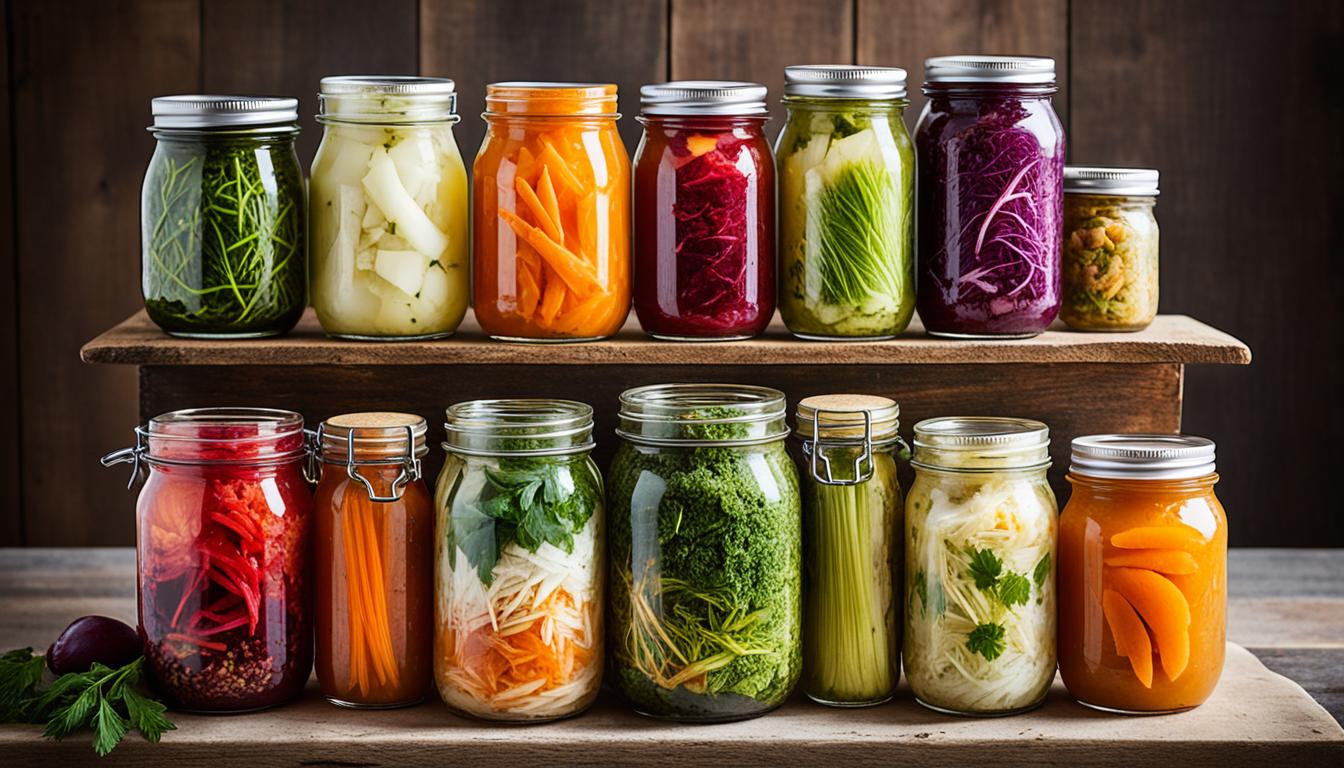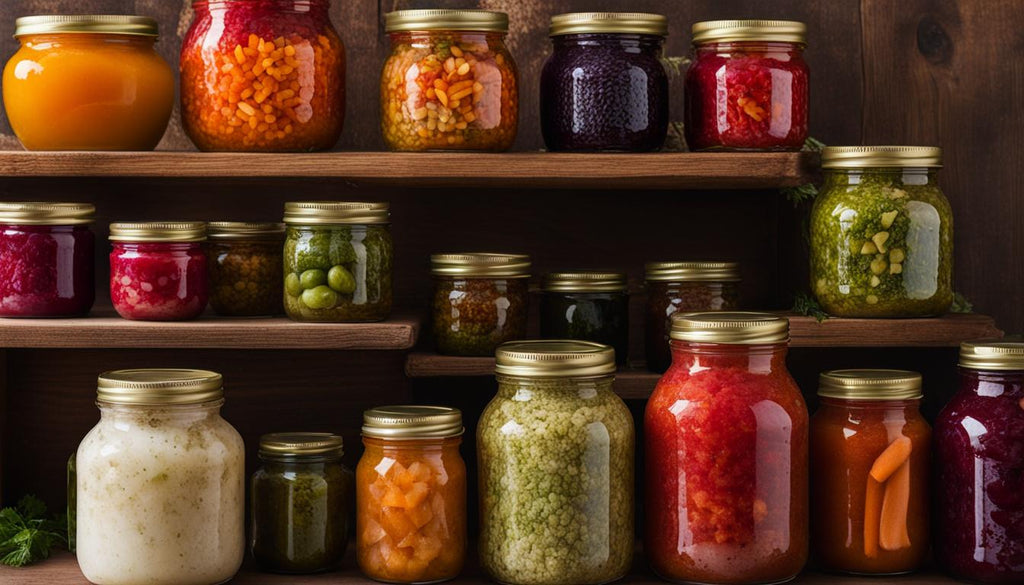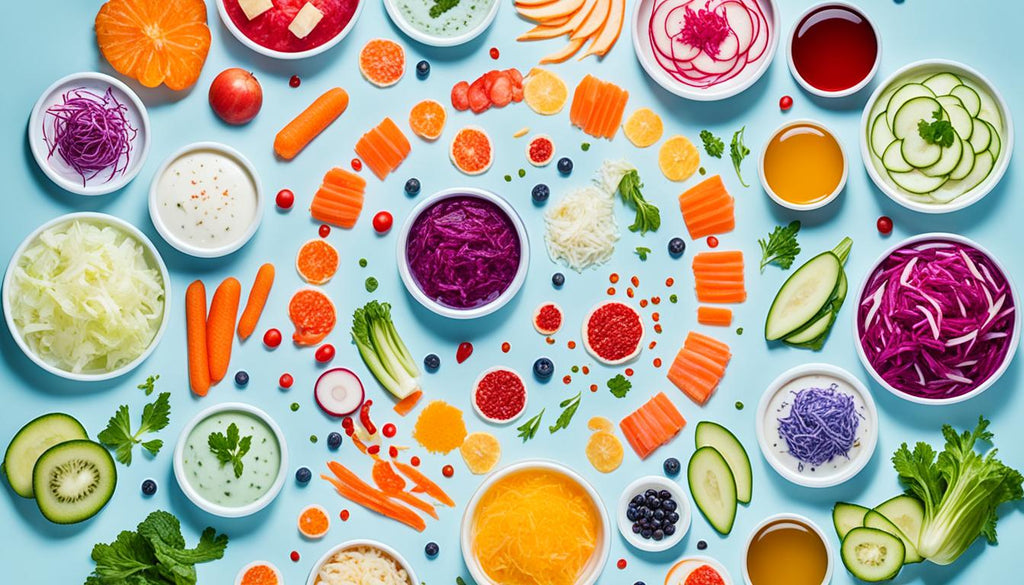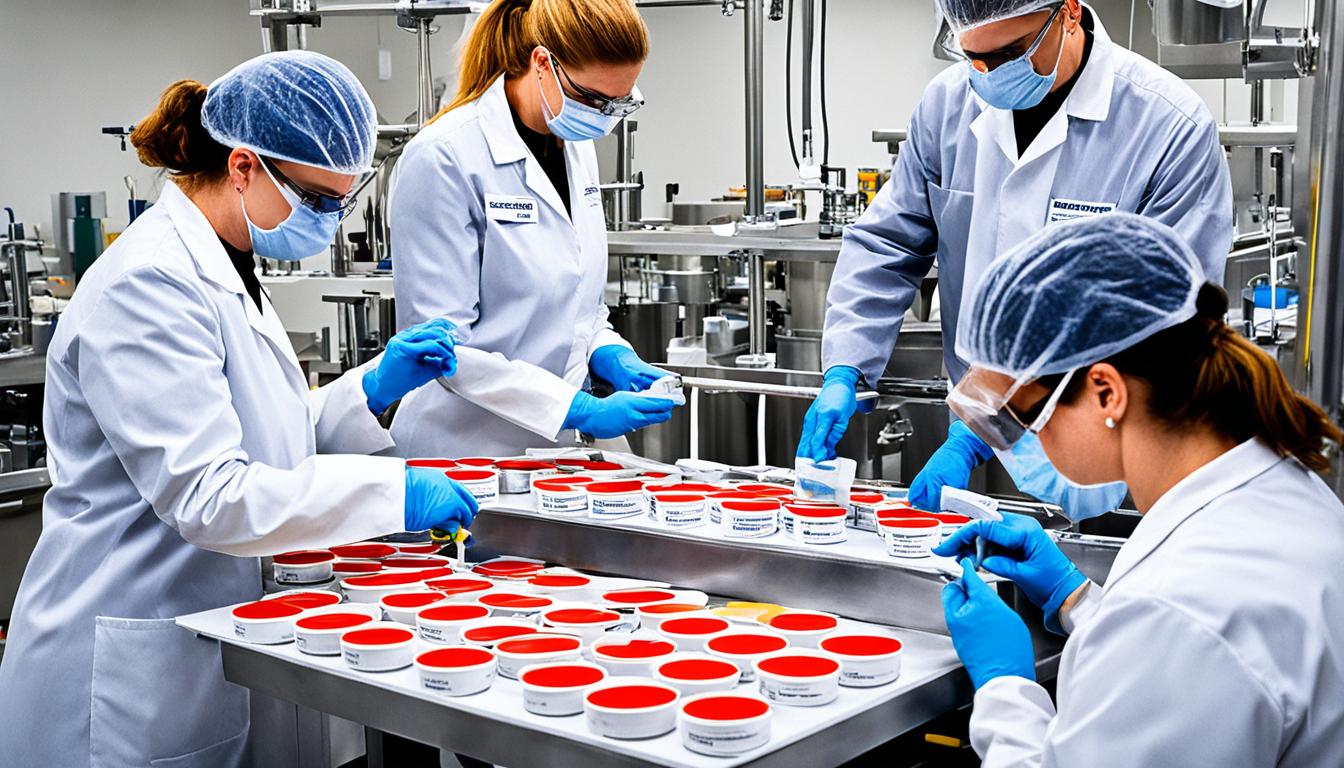
The Science of Fermentation: Health Benefits and Beginner's Recipe
SUBSCRIBE TO OUR BLOG
Promotions, new products, and recipes.
Fermentation, a natural process that has been practiced for centuries, holds the key to unlocking a world of health benefits and tantalizing flavors. By harnessing the power of microorganisms, such as lactic acid bacteria and yeast, fermentation transforms ordinary ingredients into extraordinary culinary delights. From tangy sauerkraut and probiotic-rich kefir to creamy yogurt and spicy kimchi, fermented foods not only tantalize the taste buds but also promote gut health and overall well-being.
So, what makes fermentation so special? During the fermentation process, microorganisms break down sugars and starches, producing probiotics, enzymes, vitamins, and minerals. These beneficial components provide a wide range of health benefits, including improved digestion, enhanced immune system function, reduced inflammation, and detoxification.
Key Takeaways:
- Fermentation is a natural process that converts sugars and starches into probiotic-rich and nutrient-dense foods.
- Consuming fermented foods can improve digestion, boost the immune system, reduce inflammation, and aid in detoxification.
- Popular fermented foods include sauerkraut, kefir, yogurt, kimchi, and sourdough bread.
- You can easily start fermenting at home with just a few basic tools and ingredients.
- Exploring the world of fermentation can open up a whole new realm of flavors and health benefits.
What is Fermentation and Why is It Good for You?
Fermentation is a metabolic process where microorganisms convert carbohydrates into alcohol or acids. It is a natural and age-old method used in food preparation that enhances flavor, preserves nutrients, and improves digestibility. Fermented foods have gained popularity due to their health benefits and the presence of lactic acid bacteria, which play a crucial role in the fermentation process.
Elevate your culinary creations with our advanced hydrocolloids and kitchen tools. Discover the difference on our product page.
During fermentation, microorganisms break down complex carbohydrates, such as sugars and starches, into simpler compounds like alcohol or lactic acid. This process not only increases the nutritional profile of the food but also helps in the digestion and absorption of nutrients, making them more bioavailable to the body.
Fermented foods are rich in lactic acid bacteria, which are beneficial to gut health. These bacteria help promote the growth of other beneficial gut bacteria, improving the overall balance of the microbiome. The microbiome plays a vital role in the functioning of the immune system, nutrient absorption, and even mental health.
Consuming fermented foods has been associated with several health benefits. Here are some of the notable advantages of incorporating fermented foods into your diet:
- Better digestion: Fermented foods contain enzymes that aid in the breakdown of food, making them easier to digest.
- Improved immune system: The presence of lactic acid bacteria in fermented foods can enhance the immune system by promoting the production of antibodies and boosting the activity of immune cells.
- Reduced inflammation and allergies: Fermented foods have anti-inflammatory properties that may help reduce inflammation in the body, alleviating symptoms of allergies and certain inflammatory conditions.
- Lowered blood pressure and cholesterol levels: Some studies suggest that consuming fermented foods may have a positive impact on blood pressure and cholesterol levels.
- Detoxification: Fermented foods can support the body's detoxification process by aiding in the elimination of toxins and promoting liver health.
- Positive effects on mental health: The gut-brain connection is well-established, and a healthy gut microbiome is believed to be linked to better mental health. Fermented foods contribute to a balanced gut microbiome, potentially supporting mental well-being.
Overall, fermentation is a natural and beneficial process that transforms ordinary foods into nutritious and flavorful delights. By incorporating fermented foods into your diet, you can enjoy these health benefits and support a thriving gut microbiome.
How to Ferment Food at Home?
Fermenting food at home is a simple and rewarding process that allows you to enjoy the natural flavors and health benefits of fermented foods. With just a few basic tools and ingredients, you can easily embark on your fermentation journey.
To begin, select the food you'd like to ferment. Whether it's vegetables, fruits, or dairy products, ensure they are fresh and of high quality. Next, wash, peel, and chop the food, preparing it for fermentation.
Enhance the taste and aid the fermentation process by adding spices, salt, or sugar to the food. These ingredients not only add flavor but also help control microbial activity during fermentation.
Transfer the prepared food to a clean glass jar or crock. Press it down firmly to remove any air pockets and ensure the food is submerged in its own juices.
To create an anaerobic environment for fermentation, you have a few options. You can use an airlock, a tight lid, or a cloth secured with a rubber band. These methods prevent the entry of oxygen and promote the growth of beneficial bacteria.
Place the jar or crock in a cool and dark spot, away from direct sunlight. The ideal temperature for fermentation varies depending on the food and the desired result. It's generally recommended to keep the fermentation environment between 60°F and 75°F (15°C and 24°C).
The fermentation time will vary based on the type of food and personal preference. It can range from a few days to several weeks or even months. Keep an eye on the food during the fermentation process, observing any changes in taste, texture, or aroma.
Once the fermentation is complete, taste the food to ensure it has reached the desired level of tanginess and flavor. You can then transfer it to the refrigerator for storage, where it will continue to develop its flavors, albeit at a slower rate.
Tips for Successful Home Fermentation:
- Use clean and sterilized tools and containers to prevent unwanted bacteria, mold, or yeast growth.
- Ensure the salt concentration is appropriate for the fermentation process, as it helps preserve the food and control microbial activity.
- Monitor the fermentation process regularly, looking for signs of bubbling, souring, softening, or discoloration.
- If you notice any spoiled food during the fermentation process, it's important to discard it promptly to prevent any health risks.
By following these simple steps and considering the important factors, you can successfully ferment food at home and enjoy the delicious flavors and health benefits of homemade fermented foods.
Johnny: "I've always wanted to try fermenting food at home, but I'm not sure where to start. Do you have any tips?"
Sarah: "Absolutely! It's easier than you might think. First, choose the food you'd like to ferment and prepare it by washing, peeling, and chopping. Then, add spices or salt to enhance the taste and aid the fermentation process. Transfer the food to a clean glass jar or crock, press it down firmly, and create an anaerobic environment using an airlock, lid, or cloth. Finally, find a cool and dark spot for fermentation, and patiently wait for the flavors to develop."
Johnny: "That sounds doable! How long does the fermentation process usually take?"
Sarah: "The fermentation time can vary. It can take anywhere from a few days to several weeks or months, depending on the food and your preference for tanginess. Just be sure to monitor the process and taste the food along the way to find the perfect balance."
Johnny: "Thanks for the tips! I'm excited to give it a try and enjoy the flavors of homemade fermented food."
Sarah: "You're welcome! I'm sure you'll love the results. Happy fermenting!"
Best Fermentation Recipes and Resources for Beginners
Are you a beginner looking to embark on your fermentation journey? We've got you covered with some simple and delicious fermentation recipes to get you started. Whether you're craving tangy sauerkraut, creamy yogurt, fizzy kombucha, or crunchy pickles, these recipes will satisfy your taste buds and introduce you to the wonderful world of fermentation.
Sauerkraut Recipe
Ingredients:
- 1 medium head of cabbage
- 2 tablespoons sea salt
Instructions:
- Shred the cabbage finely and place it in a large bowl.
- Add salt to the cabbage and massage it for 5 minutes until the cabbage becomes juicy.
- Transfer the cabbage and juice to a clean glass jar, pressing it down firmly to remove air bubbles.
- Cover the jar loosely and let it ferment at room temperature for about 1-2 weeks.
- Once fermented to your desired taste, transfer the jar to the fridge to slow down the fermentation process.
Yogurt Recipe
Ingredients:
- 2 cups of milk (dairy or non-dairy)
- 2 tablespoons of yogurt starter culture or store-bought yogurt with active cultures
Instructions:
- Heat the milk in a saucepan until it reaches a temperature of 180°F (82°C). Stir occasionally to prevent scorching.
- Cool the milk to about 105°F (40°C) and add the yogurt starter culture or store-bought yogurt. Mix well.
- Transfer the mixture to a clean container and cover it with a towel or lid.
- Keep the container in a warm place (around 100°F or 38°C) for 6-12 hours, allowing the yogurt to ferment and thicken.
- Once the yogurt has set, refrigerate it to stop the fermentation process. Enjoy!
Kombucha Recipe
Ingredients:
- 4-6 tea bags (black, green, or a combination)
- 1 cup of granulated sugar
- 8-10 cups of water
- 1 SCOBY (Symbiotic Culture of Bacteria and Yeast)
- 1 cup of starter tea (previously brewed kombucha)
Instructions:
- Boil the water and remove it from heat. Add the tea bags and sugar, stirring until the sugar dissolves.
- Let the tea steep and cool to room temperature.
- Transfer the tea to a clean glass jar and add the SCOBY and starter tea.
- Cover the jar with a tight-weave cloth or coffee filter, securing it with a rubber band.
- Place the jar in a warm and dark spot away from direct sunlight for 7-14 days, allowing fermentation to occur.
- After the desired fermentation period, remove the SCOBY and starter tea, reserving some of the liquid as a starter for your next batch.
- Transfer the kombucha to airtight bottles and refrigerate to carbonate it further (optional).
Pickles Recipe
Ingredients:
- 4-6 cucumbers
- 2 cloves of garlic, minced
- 1 tablespoon of dill seeds
- 2 tablespoons of sea salt
- 2 cups of water
Instructions:
- Wash the cucumbers thoroughly and slice them into spears or rounds.
- In a jar, place the cucumbers, garlic, and dill seeds.
- In a separate container, dissolve the sea salt in water to create a brine.
- Pour the brine over the cucumbers, ensuring they are fully submerged.
- Cover the jar with a tight lid and let it sit at room temperature for 3-7 days until the pickles reach your desired level of sourness.
- Once fermented, transfer the pickles to the refrigerator to halt the fermentation process.
If you're looking for more recipes and expert guidance on fermentation, resources like "The Art of Fermentation" by Sandor Katz are excellent references. They provide comprehensive information on various fermentation techniques and recipes. Additionally, websites like The Kitchen and Cultures for Health offer online tutorials and valuable resources for beginners.
Now armed with these fermentation recipes and resources, you're ready to embark on your journey to delicious and probiotic-rich homemade fermented foods. Happy fermenting!

Tips for Avoiding Common Pitfalls and Risks in Fermentation
Proper fermentation safety practices are essential to ensure the success and safety of your homemade fermented foods. Here are some important tips to help you navigate the fermentation process smoothly:
- Clean Tools and Sterilization: Before starting the fermentation process, thoroughly clean and sterilize all tools, containers, and utensils. This helps prevent the growth of unwanted bacteria, mold, or yeast that can spoil your ferment. Hot water and soap or boiling them can effectively kill any harmful microorganisms lurking on your equipment.
- Salt Concentration: The right salt concentration is crucial for fermentation to work effectively and inhibit the growth of harmful microorganisms. Use a hydrometer or follow a trusted recipe to ensure you have the correct salt concentration for your specific ferment. This will also help maintain the desired texture and taste of the final product.
- Monitoring the Fermentation Process: Regularly monitor the fermentation process to ensure everything is progressing as it should. Look for signs of activity such as bubbling, burping, or changes in color. The aroma may also change as fermentation progresses. If you notice any undesirable changes like foul odors or unusual discoloration, it could be a sign of spoilage, and the batch should be discarded.
- Discarding Spoiled Food: If you encounter spoiled or off-smelling fermented food, it's important to discard it immediately. Consuming spoiled food can lead to health issues and ruin your entire batch. Trust your senses and rely on proper hygiene practices to ensure the safety of your fermented creations.
By following these tips, you can minimize the risks associated with fermentation and increase the chances of achieving delicious and safe homemade fermented foods. Remember, cleanliness and vigilance are key to a successful fermentation journey.
Fermentation for Beginners Book Recommendation
If you're new to fermentation and eager to explore the world of probiotic foods, the book Fermentation for Beginners is a valuable resource to have. This book provides step-by-step instructions, delicious recipes, and a comprehensive overview of the science behind fermentation.
With its easy-to-follow guidance, Fermentation for Beginners is perfect for anyone looking to start their fermenting journey. Whether you're interested in making pickles, yogurt, sourdough bread, or even wine, this book covers a wide range of fermentation recipes that cater to different tastes and preferences.
The Benefits of Fermented Foods for Gut
HealthConsuming fermented foods is not only a tasty culinary experience but also a powerful way to support your gut health. These foods are packed with probiotics, which are beneficial bacteria that promote a healthy microbiome. Let's explore the benefits of fermented foods and how they positively impact your gut.
Probiotics: The Gut's Best Friend
Fermented foods are abundant in probiotics, which play a vital role in maintaining a healthy gut and overall well-being. Probiotics help balance the gut microbiome, the ecosystem of beneficial bacteria that reside in your digestive system. When the gut microbiome is in harmony, it aids in digestion, improves nutrient absorption, and boosts the immune system.
Did you know? The gut microbiome is composed of trillions of microorganisms, including bacteria, fungi, viruses, and protozoa. These microorganisms have a profound impact on your health, influencing various bodily functions.
Prebiotics: Fuel for Probiotics
Fermented foods not only contain probiotics but also prebiotics. Prebiotics are a type of dietary fiber that serves as food for probiotics, allowing them to thrive and multiply in your gut. This symbiotic relationship between prebiotics and probiotics ensures a healthy balance of gut flora, further supporting optimal digestive health.
Fun fact: Some examples of prebiotic-rich foods include onions, garlic, leeks, bananas, whole grains, and legumes.
A Thriving Microbiome for Optimal Well-being
By regularly consuming fermented foods, you provide your gut with a diverse range of beneficial bacteria. This diversity is essential for maintaining a robust and thriving microbiome. A healthy microbiome has been linked to various health benefits, including:
- Improved digestion and nutrient absorption
- Enhanced immune system function
- Reduced inflammation
- Strengthened gut barrier function
- Promotion of mental well-being
These benefits highlight the importance of incorporating fermented foods into your diet for optimal gut health and overall wellness.
| Fermented Foods | Probiotic Content | Prebiotic Content |
|---|---|---|
| Sauerkraut | Contains lactic acid bacteria | Rich in dietary fiber |
| Kefir | Contains a variety of beneficial bacteria and yeasts | May contain small amounts of complex carbohydrates (oligosaccharides) |
| Yogurt | Contains Lactobacillus and Streptococcus bacteria | May contain lactose, a type of prebiotic sugar |
| Kimchi | Contains various strains of lactic acid bacteria | Rich in fiber and beneficial compounds |
| Sourdough | Contains lactobacilli and yeasts | Naturally occurring prebiotics in wheat and other grains |
Table: Examples of Fermented Foods and Their Probiotic and Prebiotic Content
With such a wide variety of fermented foods to explore, you can easily incorporate them into your daily meals for a happy gut and improved overall health.
The Role of Fermentation in Traditional Diets
Fermentation has been an integral part of traditional diets across cultures for centuries. This ancient practice not only enhances the flavor and texture of foods but also plays a crucial role in their preservation for extended periods. Let's explore how fermentation contributes to the culinary traditions and food availability worldwide.
Flavor Enhancement and Culinary Tradition
Fermentation brings a delightful tanginess and complexity to foods, transforming them into culinary delights. This process unlocks unique flavors and aromas that are highly prized in traditional cuisines. From the sauerkraut of Germany to the kimchi of Korea, fermented foods have long been cherished for their ability to elevate dishes to new heights of taste sensation.
These traditional recipes have been passed down through generations, reflecting cultural heritage and providing a deep connection to ancestral culinary practices. Fermented foods stand as a testament to the creativity, resourcefulness, and passion of communities, their recipes cherished and celebrated as part of their cultural identity.
Nutrient Preservation and Bioavailability
Fermented foods not only delight the taste buds but also offer an array of essential nutrients. Throughout the fermentation process, beneficial bacteria break down complex compounds, making nutrients more accessible and bioavailable to our bodies. This improved nutrient absorption contributes to overall health and well-being.
Moreover, fermentation helps to preserve the vital vitamins, minerals, and enzymes found in the original ingredients. This preservation method ensures that these valuable elements remain intact despite the passage of time, allowing communities to enjoy nutrient-rich foods even during seasons when fresh produce may be scarce.
To better understand the impact of fermentation on nutrient preservation, let's take a look at this table:
| Food | Before Fermentation | After Fermentation |
|---|---|---|
| Sauerkraut | High in Vitamin C and dietary fiber | Retains high levels of Vitamin C and enhanced bioavailability of nutrients |
| Miso | Rich in protein, minerals, and B vitamins | Preserves protein content and increases the availability of B vitamins |
| Yogurt | Contains calcium, protein, and probiotics | Improves calcium absorption and boosts probiotic content |
Preserving Food and Ensuring Availability
Fermentation has proven to be a reliable method of preserving food, allowing communities to stockpile vital sustenance to sustain them during harsh climates, long winters, or prolonged journeys. By fermenting perishable ingredients, individuals were able to extend their shelf life and safeguard against potential food shortages.
This preservation technique played a significant role in ensuring food availability year-round, especially in regions where fresh produce was limited during certain seasons. By fermenting fruits, vegetables, and grains, communities could preserve their harvests and enjoy nutritious meals even when fresh alternatives were scarce.
As you can see, fermentation has had a profound impact on traditional diets, from enhancing flavor and texture to preserving nutrients and ensuring food availability. This ancient practice continues to be cherished today, with fermented foods celebrated for their cultural significance and culinary contributions.
The Impact of Fermented Foods on the Microbiome
Consuming fermented foods has a significant impact on the microbiome, the vast ecosystem of microorganisms residing in our gut. These foods introduce beneficial probiotics and promote the diversity of bacteria, fostering a healthy and balanced gut environment.
Probiotics found in fermented foods play a crucial role in populating the gut with beneficial bacteria. These friendly microorganisms support digestion, enhance the immune system, and contribute to overall gut health. By incorporating fermented foods into your diet, you can optimize the functioning of your digestive system and strengthen your body's natural defense mechanisms.
The true magic of fermented foods lies in the diverse range of bacteria they offer. Each fermented food contains a unique combination of bacteria strains, contributing to a varied microbiome. This diversity is essential for optimal gut health, as different bacteria perform different functions and work together to maintain a harmonious ecosystem.
Let's explore some popular fermented foods and the range of bacteria they provide:
Sauerkraut:
- Lactobacillus plantarum
- Leuconostoc mesenteroides
- Pediococcus pentosaceus
Yogurt:
- Lactobacillus acidophilus
- Bifidobacterium lactis
- Streptococcus thermophilus
Kimchi:
- Lactobacillus brevis
- Lactobacillus plantarum
- Weissella koreensis
As you can see, each of these fermented foods contains a unique combination of bacteria that contributes to the overall diversity of the gut. By incorporating a variety of fermented foods into your diet, you can introduce a wide range of bacterial strains, nurturing a thriving microbiome.
Ensuring a diverse microbiome through the consumption of fermented foods is essential for gut health. A balanced and thriving microbiome supports various bodily functions, including digestion, nutrient absorption, and immune system regulation. It also plays a significant role in mental health, influencing mood and cognitive function.
By prioritizing fermented foods in your diet, you can take proactive steps towards optimizing your gut health and overall well-being.
Hydrocolloids Used in Fermentation
Hydrocolloids are often used in the food industry as thickeners, gelling agents, emulsifiers, and stabilizers. Their primary role is to modify the viscosity and texture of food products, rather than directly participating in fermentation processes. However, they often play a supportive role in food fermentation in several ways:
-
Texture and Viscosity Modification: In fermented food products like yogurt, kefir, or certain types of cheese, hydrocolloids can be added to improve texture, mouthfeel, and viscosity without affecting the fermentation process itself.
-
Water Retention: Hydrocolloids can help in retaining water in fermented products, which might be beneficial in maintaining the desired consistency and preventing syneresis (water separation) in products like yogurt.
-
Stabilization: They can stabilize the product during and after fermentation, ensuring that the distribution of microbial cultures remains uniform, and the end product maintains its desired characteristics over time.
-
Encapsulation: Some advanced applications involve encapsulating probiotics or enzymes with hydrocolloids to protect them during processing or to control their release during fermentation or digestion.
Here are some hydrocolloids that might be used in fermented foods and the reasons for their use:
-
Xanthan Gum: It is often used in fermented dairy products like yogurt to improve viscosity and mouthfeel, as well as to prevent the separation of whey (syneresis). Xanthan gum is effective in small quantities and provides a stable product over a wide range of temperatures and pH levels.
-
Guar Gum: This hydrocolloid can be used in similar applications as xanthan gum, such as in fermented milk products, to improve texture and maintain uniformity. It's particularly useful for its high solubility and low viscosity at low concentrations.
-
Pectin: In fermented fruit beverages, pectin can help stabilize the suspension of fruit particles and improve mouthfeel. It's also used in fruit-based fermented products to enhance gel formation and consistency.
-
Alginate: While not directly involved in the fermentation process, alginate can be used in post-fermentation applications, such as in the encapsulation of probiotics for addition to fermented foods or for forming protective gels around fermented food beads (e.g., in molecular gastronomy).
-
Carrageenan: In fermented dairy products like yogurt and cheese, carrageenan can help improve texture, mouthfeel, and stability. It helps to distribute the protein evenly, preventing separation and ensuring a smooth product.
-
Agar-Agar: Although less common in fermented foods, agar-agar can be used in vegan fermented products as a gelling agent to create firm textures, especially in products intended to mimic the consistency of traditional gelatin-based foods.
These hydrocolloids are chosen based on their ability to interact with the food matrix of fermented products, enhancing texture, stability, and overall sensory attributes without adversely affecting the fermentation process or the growth of beneficial microorganisms. While hydrocolloids are not directly involved in the metabolic pathways of fermentation (which are driven by microorganisms like bacteria, yeasts, and molds), they are valuable in formulating fermented food products with desirable textures, stability, and nutritional profiles.
Boosting Your Health with Homemade Fermented Foods
Making homemade fermented foods allows you to take control of your health. These foods provide numerous health benefits, including boosting the immune system, increasing nutrient bioavailability, and providing antioxidants. Homemade fermented foods also promote digestive health and can be incorporated into various dishes for added flavor and nutrition.
Fermentation enhances the nutritional profile of foods, making them more easily digestible and increasing the bioavailability of essential nutrients. This means that your body can absorb and utilize nutrients more efficiently, supporting overall health and well-being. Fermented foods are also rich in antioxidants, which help protect the body against harmful free radicals and oxidative stress.
The immune system is a key component of our overall health, and consuming homemade fermented foods can help strengthen it. These foods are packed with beneficial bacteria that support a healthy gut microbiome, which plays a crucial role in immune function. By promoting a balanced and diverse gut microbiota, fermented foods can help enhance immune response and protect against infections and diseases.
In addition to immune support and improved nutrient absorption, homemade fermented foods also contribute to digestive health. The beneficial bacteria present in fermented foods aid in digestion, break down complex carbohydrates, and promote a healthy gut environment. They can help alleviate digestive issues such as bloating, gas, and constipation, and improve overall gut health.

Health Benefits of Homemade Fermented Foods
| Health Benefits | |
|---|---|
| Boosts immune system | Supports the growth of beneficial bacteria in the gut and strengthens immune response |
| Increases nutrient bioavailability | Enhances the absorption and utilization of essential nutrients |
| Provides antioxidants | Protects against free radicals and oxidative stress |
| Promotes digestive health | Aids in digestion, alleviates digestive issues, and supports a healthy gut environment |
By fermenting at home, you have the freedom to experiment with different ingredients and flavors, tailoring the recipes to suit your taste preferences. You can also ensure the quality and freshness of the ingredients used, making homemade fermented foods a healthier option compared to store-bought varieties that may contain additives or preservatives.
Incorporating homemade fermented foods into your diet is easy and versatile. You can enjoy them as toppings for salads, in sandwiches and wraps, or as a side dish to complement your meals. Adding a dollop of fermented foods like sauerkraut or kimchi can provide a delicious and nutritious boost to your dishes.
Experience the health benefits of homemade fermented foods by starting your fermentation journey today. With a few simple steps, you can unlock a world of delicious flavors, improved digestion, and enhanced well-being.
Conclusion
Fermentation is a fascinating process that unlocks a world of health benefits. By incorporating homemade fermented foods into your diet, you can take a proactive approach towards improving your gut health, digestion, and overall well-being. These probiotic-rich foods can be a valuable addition to a healthy lifestyle.
Research shows that fermented foods play a crucial role in cultivating a thriving microbiome, supporting the immune system, and increasing the bioavailability of nutrients. With their rich content of beneficial bacteria, probiotics, and enzymes, fermented foods help maintain a balanced gut environment and promote optimal digestion.
By exploring different fermentation recipes and experimenting with flavors, you can unlock a wide variety of homemade fermented foods that suit your taste preferences. Whether it's sauerkraut, yogurt, kimchi, or kombucha, these fermented creations offer a delicious way to enhance your health.
FAQ
What is fermentation?
Fermentation is a natural process in which microorganisms like bacteria and yeast break down sugars and starches in food, resulting in tangy, sour, or fizzy flavors and textures while preserving the food.
What are the health benefits of fermentation?
Fermented foods are rich in probiotics, enzymes, vitamins, and minerals, which provide numerous health benefits like improved digestion, enhanced immune system, reduced inflammation, and detoxification.
How can I ferment food at home?
To ferment food at home, you will need tools like a glass jar or crock, ingredients, and patience. Start by preparing the food of your choice, adding salt, spices, or sugar as needed. Transfer it to a clean jar or crock and create an anaerobic environment using an airlock, tight lid, or cloth. Place it in a cool and dark spot for the desired fermentation time.
How can I ensure safety during fermentation?
To ensure safety during fermentation, use clean and sterilized tools, maintain the right salt concentration, monitor the fermentation process regularly for signs of spoilage, and discard any spoiled food to avoid health issues.
How do fermented foods benefit gut health?
Fermented foods are rich in probiotics, which are beneficial bacteria that promote a healthy microbiome and aid in digestion, nutrient absorption, and immune system function. They also contain prebiotics, which support the growth of probiotics, further enhancing gut health.
What is the role of fermentation in traditional diets?
Fermentation has been a fundamental practice in traditional diets across cultures for centuries. It enhances the flavor and texture of foods, preserves them for longer shelf life, and contributes to nutrient preservation and bioavailability.
How do fermented foods impact the microbiome?
Consuming fermented foods introduces beneficial probiotics to the microbiome, promoting the growth of healthy bacteria and contributing to a balanced and thriving microbial community in the gut, which is essential for overall gut health and well-being.
What are the health benefits of homemade fermented foods?
Homemade fermented foods provide numerous health benefits, including boosting the immune system, increasing nutrient bioavailability, providing antioxidants, promoting digestive health, and offering a flavorful and nutritious addition to various dishes.
What are the key takeaways about fermentation and its benefits?
Fermentation is a fascinating process that offers numerous health benefits. From improving gut health and digestion to boosting the immune system and increasing nutrient bioavailability, homemade fermented foods can be a valuable addition to a healthy diet. By incorporating probiotic-rich foods into your routine, you can cultivate a thriving microbiome and support overall well-being.
Well That's the Story. I hope it was helpful. Let's Hear Your Thoughts!
We've shared our insights, and now it's your turn! Have an opinion, a question, or a story to share about this article? Dive into the comments below and join the conversation. Your voice is a crucial part of this community, and we're eager to hear what you have to say.
Thought that was fascinating? Here’s another story you might like:
See: The Hydrocolloid Glossary
For further readingabout yogurt's benefits
The Art of Juicy and Flavorful Sausages: The Secret Role of Natural Gelling
Every dish deserves the perfect texture to complement its flavors. Why settle for anything less than perfection? With Cape Crystal Brands Food Texture products, you don't have to. Whether you're crafting velvety sauces, glistening gels, or fluffy mousses, our range ensures you get the consistency you desire every single time.
Don't just cook—create masterpieces. Dive into the world of culinary textures and elevate every meal. Shop now and experience the magic of Cape Crystal!
🛍️ Click Here to Explore Cape Crystal Brands Food Texture Products!

Chef Edmund
Edmund McCormick is the founder of Cape Crystal Brands and EnvironMolds LLC. He is the author of several non-fiction “How-to” books, past publisher of the ArtMolds Journal Magazine, editor of Beginner's Guide to Hydrocolloids, and author of six eBook recipe books available for download on this site. He resides in Far Hill, NJ and lives and breathes his food blogs as both writer and editor. You can follow him on Twitter and Linkedin.
- Choosing a selection results in a full page refresh.





